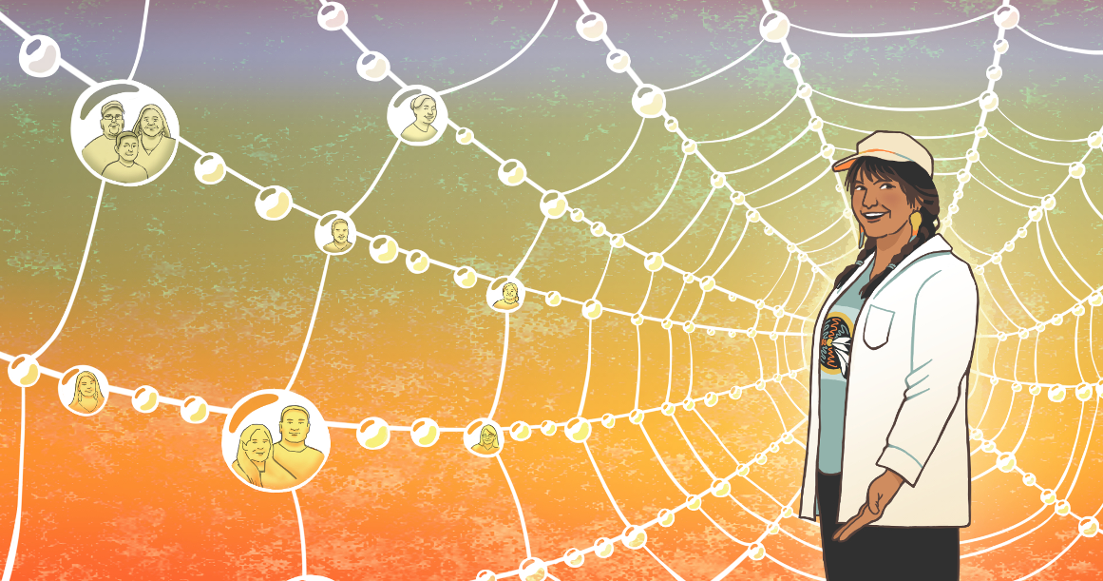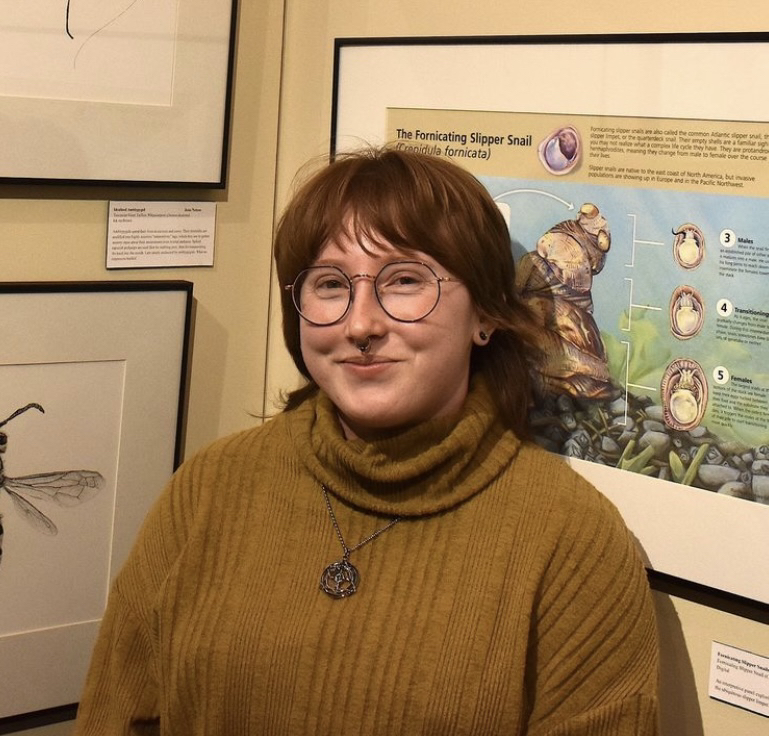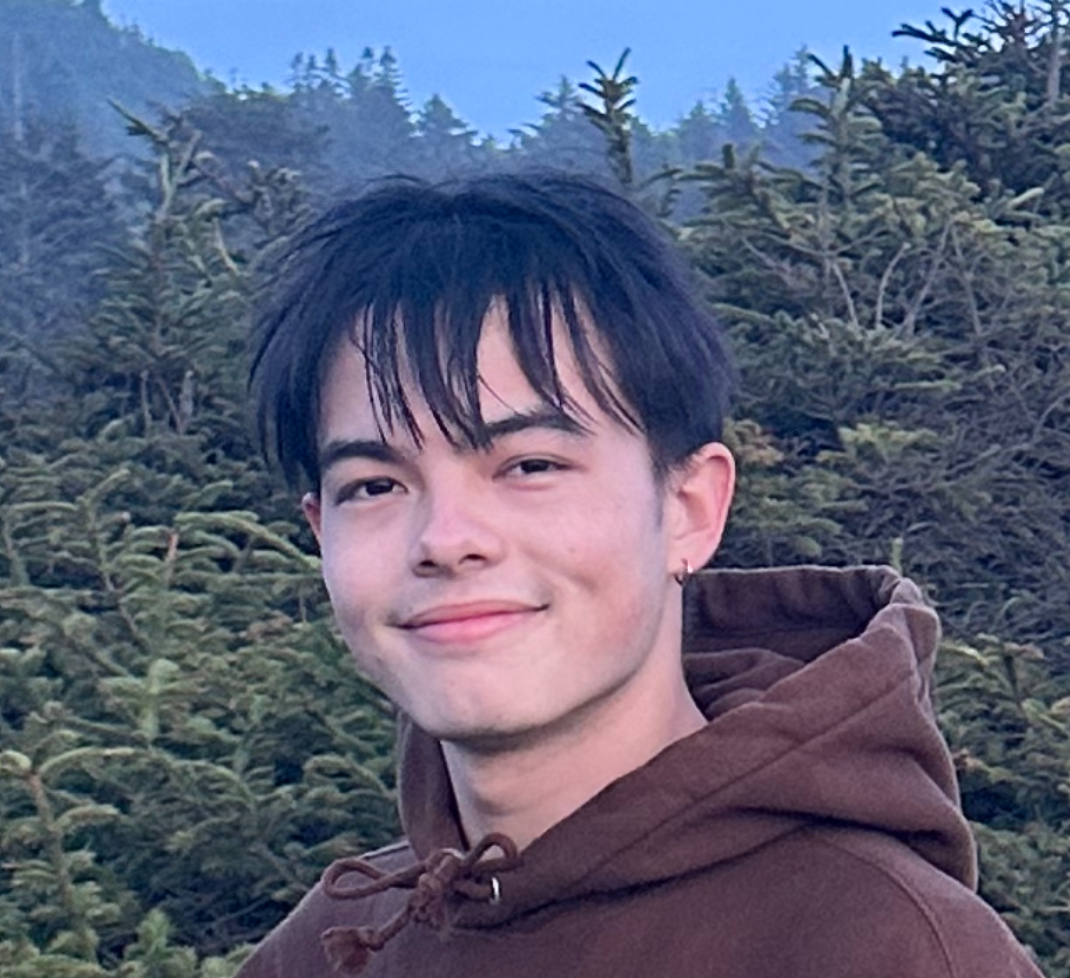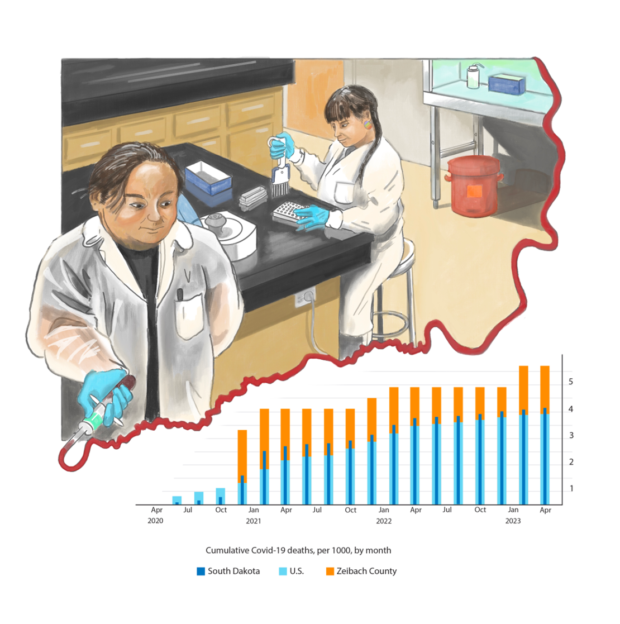Digital Native: How Indigenous scientists tackle COVID-19 and data sovereignty
The Native BioData Consortium, an Indigenous scientists’ organization, tackles data sovereignty with COVID-19 data through a $9million grant from the National Institutes of Health. Kali Dale, the project lead, details her path to becoming a scientist and what this project means for Indigenous communities, Eli Ramos reports. Illustrations by Josie Nelson and Parker Wong.

Illustration: Josie Nelson
Twenty years ago, Carletta Tilousi triggered a landmark data sovereignty case by asking a single question: “Did you have permission?” Tilousi, a member of the Havasupai Native American tribe and the Havasupai Tribal Council, posed that question at a university conference, where scientists were presenting data collected from her tribe. She was one of approximately 400 members of the tribe who had agreed to supply her genetic information to researchers from Arizona State University: John Martin and Therese Markow.
The tribe had experienced an increase in cases of diabetes, which disproportionately affects Native American people, and wanted to know if the cause was genetic. Markow collected blood samples, handprints and fingerprints from the Havasupai. The researchers tested the samples for genetic causes of diabetes and found none. But the testing didn’t stop there.
After the samples were stored, they were used in studies researching ethnic migration, schizophrenia, and inbreeding—all of which are taboo topics in the Havasupai tribe. So, in 2004, the Havasupai tribe filed a lawsuit against the Arizona Board of Regents.
Six years later, in 2010, the case was finally settled with direct compensation of $700,000 to tribal members who were affected. providing funding for a tribal school and returning the DNA samples to the tribe. But the data collected from those people could not and cannot be returned. Once data is released, there’s rarely any control over who can access it, where it goes, and what it’s used for.
Now, Kali Dale, a scientist from the White Earth Ojibwe tribe, and a team of other Indigenous scientists at the Native BioData Consortium, an Indigenous nonprofit research organization based in South Dakota, must figure out how to protect that data. Indigenous peoples have needed to protect their resources from the extractive behaviors perpetuated by the United States. The United States’ violent legacy of colonialism has impacted how scientists view ownership over Indigenous data, as shown in the Havasupai case. In December 2023, the National Institutes of Health awarded $9 million to the Native BioData Consortium for the creation of a Tribal Data Repository, currently storing COVID-19 related data collected from Indigenous tribes in the United States. It’s the first time a grant of this size was awarded directly to an Indigenous organization from the NIH. The Native BioData Consortium will create the Tribal Data Repository in collaboration with large universities across the United States.
The project prioritizes data sovereignty: an individual or group’s right to control and maintain their own data. Joe Yracheta, the vice president of Native BioData Consortium and member of the Pūrepecha tribe, says the funding represents a major step for the United States government in repairing the extractive behaviors of the past—and gives Indigenous people control over a resource that becomes more and more valuable in an increasingly data-driven age.
And globally, Indigenous people have been setting the precedent for data sovereignty in science. “We’re setting the trends,” said Krystal Tsosie, co-founder of Native BioData Consortium.
Stolen Data
Data is a four-letter word representative of information: it can be numbers, survey responses, genetic sequences, or anything else that can be stored digitally. In our increasingly computerized world, data has become increasingly valuable. The potential monetary value of data makes it ripe for exploitation, especially when the data is gathered from marginalized groups by those with money and power. Even ground-breaking research with tangible benefits to humanity has at times originated in a violation of consent and collection of data, such as the case of Henrietta Lacks. Lacks is the origin of HeLa cells, which are used in groundbreaking medical research—but her cells were taken without consent or financial compensation for the cures that derive from her data. This kind of exploitation can seem like a thing of the past, but companies, researchers and institutions still take advantage of sensitive data without the consent of its rightful owners in the name of profit or other gains.
Burt Dillabaugh, one of Dale’s employees and a tribal member of the Cheyenne River Sioux, conducts outreach on the Cheyenne River Sioux Indian reservation educating residents on data sovereignty. Indigenous people easily grasp the concept, he said. “Native people and specifically tribal people understand what exploitation is,” said Dillabaugh. “We understand people coming with seemingly one purpose and then doing something else.”
“Companies, people, even the U.S. government wants to search in our DNA to try to find things, and if they do find something that’s beneficial, there’s gonna be a lot of money made off of that,” said Dillabaugh. “We want people whose biological samples are used… to benefit from the profits that could be generated off of that. There’s potential value in our data. And we need to protect it now.”
Globally, Indigenous people have been paying attention to where their data goes. The Te Mana Raraunga – Maori Data Sovereignty Network, established in 2015, was one of the first to argue that data collected from tribal nations should be subject to the laws of those nations. In the same year, Stanford Precision Health for Ethnic and Racial Equity (SPHERE) established a community advisory group of tribal members to work on their research projects—one of the origins of Native BioData Consortium.
“We started Native Bio with a very simple premise: that research on Indigenous peoples’ samples should be led by Indigenous community members and Indigenous scientists,” said Tsosie in an Arizona State University press release. That attitude in recent years has extended to data, where Native BioData Consortium argues that Indigenous people should be in charge of their own data.
In the case of the Tribal Data Repository (TDR), it serves as a landmark framework within the U.S. government system. Though the non-physical data in the form of numbers and statistics will be uploaded to the NIH databases, which are accessed by a variety of organizations and entities, the TDR allows Indigenous people and tribes to consent to their data’s use and the kinds of scenarios it can be used in.
Keeping Data Open
The data sovereignty movement is not without its critics. Dale has heard some say that data sovereignty closes off access to data that could be beneficial to humanity. For example, there has been a recent push by scientists to collect biological data from Indigenous people, such as analyzing and preserving their gut microbiomes to preserve ancient lineages of bacteria. “Native DNA is so sought after that people are looking for proxy data, and one of the big proxy data is the microbiome,” said Yracheta in a 2021 New York Times article. “If you’re a Native person, you have to consider all these variables if you want to protect your people and your culture.”
Anonymous people at Native BioData Consortium’s panels have drawn parallels between their biobank and the UK Biobank, which has open access data, meaning any researcher can access any data uploaded to it without special permissions or paywalls blocking them. UK Biobank’s strategy has allowed for collaborative research at a scale previously unseen, especially in medical research, where it has helped fuel discovery and innovation for academics and private companies alike.
But, Dale argues, open access data lacks context because it is separated from the people behind the data, stripping away cultural meaning and nuance. “They won’t have the narrative behind this data—and if you want it done correctly, we want it to be done with our perspective,” said Dale. “And they don’t have our perspective unless they’re working with us.”
A Culture of Care
“For me, as an Indigenous person, [our] data is telling me my ancestors’ stories,” said Dale. She was fascinated by science and numbers as a child, seeing them as a puzzle to solve. “My core has always been numbers,” she said.
Dale’s mom was a nurse at the Indian Health Services in Bemidji, Minnesota, who created public health programming for the four Native American communities in the area. “At the time, I thought it was boring, but I really looked up to her,” said Dale.
Around the time that Dale was nine years old, her grandfather suffered a debilitating stroke when she was over at his house—one of her first encounters with a serious medical condition. Later, her grandmother developed dementia, meaning her grandparents required around the clock care.
Dale’s tight-knit family was, like many Indigenous families, a multi-generational household. Family members took turns caring for her grandparents every night. “Taking care of people like that is just Native culture,” said Dale. Watching her mom’s nursing practices in action within her family inspired her to a career in healthcare. “The narrative that I heard growing up from her and from other Native healthcare workers is that there’s not enough Native healthcare workers, and Native people want to be treated by Native people,” she said. “I wanted to be a pharmacist, a doctor, a dentist—all those things.”
Indigenous Health
As an undergraduate in her junior year, Dale was well along her journey to healthcare at the University of Minnesota Morris. The school was once an American Indian boarding school run by Catholic nuns under a U.S. government contract—Dale’s great-grandmother was forced to attend there before the state of Minnesota took over. When the school became a state-run university, tuition remained free for all Native students, meaning Dale was among other Indigenous students during her time there. But her path into the healthcare field diverged when she pursued a research opportunity at the University of Utah, called the Native American Research Internship (NARI).
The research internship exposed Dale to more Native professionals and to research documenting the health disparities affecting Native people. In the U.S., American Indians and Alaska Natives have a lower life expectancy compared to other races by 5.5 years, higher incidences of heart disease and diabetes, and the second highest infant mortality rates after Black populations.
“I kind of switched gears from being a healthcare professional to doing research. It felt like I could make a bigger impact,” Dale said. “I’ve always cared about helping my community and research was really, really intriguing to me.”
But Dale admitted that she lost sight of her desire to help people during grad school. Her work there focused on melanoma, a skin cancer that typically affects people with fair skin. Utah’s incidences of melanoma are higher than any state in the country due to its high elevation and large population of people with fair skin. “I really lost passion for that project over time just because I was like, ‘This isn’t helping my people.’”
What refocused her was mentoring for NARI and attending IndigiData—a workshop created in 2021 by the Native BioData Consortium that focused on educating Indigenous people about data sovereignty. After the workshop sparked her interest in the connections between Native health and data, Dale contacted Native BioData Consortium to ask if they would hire her once she graduated.
COVID-19 on the Cheyenne River Sioux Reservation
Indigenous communities were hit extremely hard by COVID-19. From the start of the pandemic up to 2023, one out of every 201 Indigenous Americans died from COVID-19, according to APM Research Lab—as opposed to 1 in 259 White Americans. Indigenous deaths are also often undercounted, with a 2021 CDC report estimating that the true Indigenous mortality rate could be around 34% higher the official count. Many Indigenous communities are in rural areas and on reservations with limited access to medical resources or running water, exacerbating the pandemic’s toll on Indigenous Americans.

“Obviously our communities were super affected,” said Dale, “but I think there was this [unfair] stigma that reservations couldn’t take care of themselves.” Early access to testing, which was often not provided by the government to far-reaching communities, could have curbed the spread of the disease. For those living in multi-generational homes, a common practice in Indigenous communities, test results could have helped encourage infected individuals to isolate from vulnerable family members. When testing did become available, many samples needed to be processed off-reservation, which sometimes delayed results for weeks. Sending out these samples also caused Indigenous communities to lose access and control over their data—including vital information about which variants of the COVID virus were circulating in the community.
As part of the attempt to address inequities in COVID-19 testing, the NIH launched the Rapid Acceleration of Diagnostics (RADx) initiative in 2020, which helped fund the Native BioData Consortium’s research project on Cheyenne River Sioux Reservation through RADx-Underserved Populations (RADx-UP).
As part of this RADx-UP work, every workday in 2022, Dale would leave her house at 9 a.m. and drive 55 miles across the Cheyenne River Indian Reservation in South Dakota to the laboratory where she worked. She would arrive there at 9 a.m.—a quirk of travelling between time zones on a reservation roughly the size of Connecticut. Dale had recently been hired at the Native BioData Consortium as their director of research. Along with a small team of four other staff, she was tasked with taking over the massive project of collecting all COVID related data at the Native BioData Consortium’s lab at Cheyenne River, which would understand and address the toll of COVID for those living there.
The lab and the hospital that services the roughly 8,000 people who live on the reservation are centrally located, but, like Dale, many residents don’t live nearby and must drive anywhere from 50 to 90 minutes for healthcare.
Dale’s first order of business in her new role was to develop a survey for anyone who came to the laboratory for COVID testing. The survey collected essential medical information and ensured they received incentives (a $25 gift card for local services in the reservation) if it was their first visit. She and her lab techs would swab patients, perform the 40-minute test for COVID in the lab and then store the patient samples. If the patient had COVID, she would offer another $25 incentive to draw their blood to test for long COVID. Then, she’d sequence any COVID samples to see which variants were circulating, perform data analysis on both the surveys and COVID variants, and report COVID and flu rates to the Indian Health Services hospital every month.
With a chuckle, Dale said, “I’m kind of in all aspects of the data.”
Native BioData Consortium became Clinical Laboratory Improvement Amendments (CLIA) certified, meaning their laboratory was approved to handle every aspect of testing patient samples. Handling all aspects of testing and data management created a huge amount of work for Dale and her team, but ensured their samples and data remained under Indigenous control. The samples—test tubes of Native blood, spit, and mucus—never left the reservation, guaranteeing Indigenous people access to their samples. The surveys, designed by Dale and her team, also were more tailored to the Native people that they tested day after day, rather than using the NIH survey that was more generic.
In partnership with Stanford, the genetic data analysis done by the Native BioData Consortium is also corroborated by Stanford UniversityStanford’s long-standing partnership with Native BioData Consortium has fostered trust between Indigenous scientists and their allies. “I hope that having this testing provides a sense of safety and ownership, and that there’s a reliable place to do this,” said Dale.
Since the testing is part of an ongoing RADx project, the team was required to survey participants, gathering consent, demographic details, medical information, and health outcomes. That survey data, along with data from 11 other tribes involved in RADx-UP’s projects will be entered into the Tribal Data Repository once the framework is in place.
The Cost of Sovereignty
“It’s become quite evident that the amount of data that we’re going to handle is quite small,” said Ann Mc Cartney, one of the scientists responsible for building the framework of the Tribal Data Repository. As it currently stands, the data they’re beginning this project with is from the Cheyenne River Sioux tribe. While they’re one of the larger tribes, the data won’t require $9 million to manage and store according to Mc Cartney. She continued, “But we’re thinking about the infrastructure of how we work with communities.” But as the project expands to the other tribes whose data was collected through RADx-UP and beyond, the infrastructure will need to accommodate larger datasets with wider ranges.
Mc Cartney, who has worked with both the NIH and similar frameworks in Aotearoa (the Maori word for New Zealand), says that their work in 2024 will be mostly focused on organizing how to manage the money. The grant is split across Native BioData Consortium as well as six major universities: Stanford University; Arizona State University; Ohio State University; University of California, Santa Cruz; University of Washington, Seattle; and University of Wisconsin, Madison. Part of the grant is going to recruiting postdoctoral researchers and PhDs who will help build out the infrastructure needed to store samples on Indigenous land. Another portion of the money goes to tribal outreach. While some tribes have had conversations and have established research policies, such as the Havasupai, others may not have contended with the issue from a bioethical standpoint.
Dillabaugh said it is crucial to communicate with Indigenous people, tribes, and tribal governments. “We need to have an infrastructure in place ahead of time to make sure that we are protected and our interests in that are protected,” he added.
Since April, Native BioData Consortium has met with several tribes through their partner, TribalVentures, and presented the project at conferences like the Indigenous Data Summit. Dale says that there’s been support from other Indigenous groups in Canada and Aotearoa. Much of the grant funds will need to be used to cover the legal side of Tribal Data Repository, according to Yracheta. “There’s been a conflict between tribes, federal, and state governments over Indigenous data,” said Yracheta. “The data that’s been collected by the federal government here doesn’t belong to them—it belongs to Indigenous tribes who have their own privacy, economic, implementation, and nation metrics. And data is a resource that cannot just be handed over without remediation or benefit.”
But the project is currently going through rebudgeting. The grant was given for a one-year project with a hope for two no-cost extensions. Now, they only have funding for 15 more months instead. Both the NIH and the Native BioData Consortium are looking for more funding to preserve the project–especially now that they have started work on the dynamic consent portal.
Educating the Community
The information in RADx repositories is an available resource for researchers now. In fact, they have a repository to make their work as open as possible. The dynamic consent portal that Native BioData Consortium developing functions on community and tribal-based consent, which means there’s no single administrator access to all the data–tribes and other Indigenous groups must grant access to specific data. To ensure that these groups know how to do so, Native BioData Consortium now focuses strongly on educating Indigenous people on the topic and their rights.
Though Native BioData Consortium wasn’t originally created with the intent to educate, Dillabaugh says that in working with data, it became a priority of the organization. He believes the education is crucial, even though many Indigenous communities are focused on more immediate issues, because these things matter in the long run. In his position as a liaison, Dillabaugh communicates with both the tribal government and tribe members about data sovereignty and their legal right to control their data.
Though financial gain has yet to come from Indigenous data sources, Dillabaugh argues that it’s important to set the framework now to get ahead of the curve.
Yracheta hopes that the work of the Native BioData Consortium and establishing the Tribal Data Repository will help set a precedent for restorative justice. “Our goals at Native Bio are for true diversity, equity, inclusion, and social justice,” said Yracheta. “We want to decolonize data and science. If we keep going the way we’re going, it’ll entrench and make permanent the settler-colonial mindset.”
Dale, whose journey with Native BioData Consortium began with the IndigiData workshops, sees that education as a path forward. “Doing this work feels heavy. There’s this weight and this need for our people to take care of our people. That weight presses harder and harder when I’m looking at these public databases that don’t even list Native people. We’ve contributed to science without benefit in the past.”
And it’s not without its struggles now, especially as the project has been restructured and the costs of the work hang in the balance. “The budgeting has been really difficult because we may have to archive [the consent portal] if we don’t receive funding. We’re not gonna throw it away. But it’s of great interest for the NIH and it feels so important and heavy to let go of. We really want to see it continuing on to benefit Native communities that may be affected by future pandemics and epidemics.”
There’s a bright side for Dale, in spite of it all. “All the work I’ve been doing now helps me to do the work that really matters at my core and the core of my community. It’s going to benefit not just our community, but other communities as well because it’s going to have this spiderweb effect. And I know that spiderweb can handle the weight. No matter what, we can’t stop, won’t stop.”
© 2024 Eli Ramos / UC Santa Cruz Science Communication Program

Eli Ramos
Author
B.S. Biology, University of San Francisco
Internships: Monterey Herald, Science, Stanford University
As a docent at a science museum, I used to explain natural phenomena to guests in a rainforest exhibit. By luck one day, a blue morpho butterfly landed on my arm, and the museum-goers watched it shift from electric blue to dead-leaf brown, then back again. As I explained the magic of structural color, the excitement in my audience’s eyes was as striking as the butterfly that took to the sky.I adore science; I chased it through lectures and library programs, molecular laboratories and museums. But not everyone knows how to take the first step to understanding it. And I realized my passion for storytelling could help bridge that gap.As a science communicator, I want to make the path to understanding accessible for the diverse, curious minds in the world. Enthusiasm for science empowers everyone, especially marginalized communities, to find solutions to the crises facing us today.

Josie Nelson
Illustrator
I’m Josie! I’m a multimedia nature artist currently based in Reno, Nevada. I specialize in vibrant and comical
nature art that aims to foster a feeling of intimacy between the subject and the viewer. My favorite subjects are invertebrates, especially arachnids. By inviting viewers to engage with underrepresented species through a whimsical lens, I hope to inspire wider curiosity, compassion, and support for nature conservation efforts.

Parker Wong
Illustrator
B.F.A (Printmaking) Evergreen State College, Washington
Parker Wong is a multimedia artist from Charlotte, North Carolina. Early on, his focus was watercolor and ink, and his preferred subject matter was anything that he could sit in front of. After studying printmaking at The Evergreen State College in undergrad, Parker attended the science illustration program at Cal State Monterey Bay. Here, he learned to appreciate taking a closer look at his artistic practice and developed the skills to make more thoughtful and complex illustrations.
